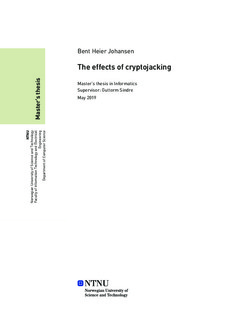| dc.contributor.advisor | Sindre, Guttorm | |
| dc.contributor.advisor | Meland, Per Håkon | |
| dc.contributor.author | Johansen, Bent Heier | |
| dc.date.accessioned | 2019-10-26T14:01:17Z | |
| dc.date.available | 2019-10-26T14:01:17Z | |
| dc.date.issued | 2019 | |
| dc.identifier.uri | http://hdl.handle.net/11250/2624624 | |
| dc.description.abstract | Cryptojacking er utnyttelsen av internettbrukeres båndbredde og prosseseringskraft for å mine kryptovaluta. Seint i 2017 og gjennom 2018 dukket cryptojacking opp som en av de største truslene online og ble nesten like stort som all annen malware til sammen. Bak denne nye truslen var den økende populariteten til Monero, en kryptovalutta som det er mulig å mine på konsumer hardware, den ekplosive veksten av de fleste populære kryptovalutaer og Coinhives oppstart, en tjeneste som gjorde nettleserbasert kryptominig til et levedyktig alternativ.
Cryptojacking så en nedgang i 2019, men selv om det skulle vise seg å være en kortlivd trussel var det stor intresse for fenomenet blant datasikkerthetsmiljøet. Flere ondsinnede aktører har antagelig tjent gode penger på cryptojacking. I skrivende stund er er det umulig å vite om cryptojacking igjen vil bli en seriøs trussel eller ikke, men lærdommene fra fenomenet er uansett intresante.
Denne oppgaven vil prøve å forstå hvordan cryptojacking påvirker systemer og brukere som lider under det, så vel som hvor levedyktig cryptojacking er som inntekskilde for de som begår det og forstå hovedforskjellene mellom ulike typer cryptojackingangrep. Dette er gjort gjennom en gjennomgang av tilgjenglig litteratur, kontrollerte eksprimet og analyse av profitten skapt via cryptojacking over lengere tid and kostdata relatert til cryptojacking.
Hovedfunnene er at cryptojacking ikke skader ofrene sine betydelig og det er relativt enkelt å beskytte seg mot. På den annen side er kosten og risikoen tilknyttet cryptojacking svert lave. Hovedkostnadden er alternativkosten, ettersom det er andre måter å misbruke kompromitterte systemer og så lenge kryptomarkedene er i nedgang er ikke cryptojacking like profitabelt som alternativene. | |
| dc.description.abstract | Cryptojacking is the exploitation of internet users’ bandwidth and processing power to mine cryptocurrencies. In late 2017 and through 2018 cryptojacking emerged as one of the largest online threats, rivaling all other malware. The enablers for this new threat was the rising popularity of Monero, a cryptocurrency that is viable to be mined on consumer grade hardware, the explosive value growth of most popular cryptocurrency and the start of Coinhive, a service that made web browser based cryptomining a viable alternative.
Cryptojacking has seen a decline in 2019 and while it might have been just a short time threat it took the keen interest of a large part of the computer security community. Several nefarious actors are likely to have made quite a profit from it. As of the writing of this thesis it is impossible to know whether cryptojacking will become a serious threat again or not, but the lessons that can be learned from it are interesting none the less.
This thesis seeks to understand how cryptojacking effects the systems and users suffering from it, as well as the viability of cryptojacking as a source of income for those perpetuating it and understanding the main differences between different kinds of cryptojacking attacks. This is done through an investigation of the available literature, controlled experiments and analysis of the profits created by cryptojacking over a prolonged amount of time and analysis of the cost data related to it.
The main findings is that cryptojacking does not significantly harm it's victims and it is relatively easy to protect against. On the other hand the costs and risk associated with performing cryptojacking are quite low. The main costs are the opportunity costs, as there are other ways to abuse compromised systems, and when the cryptocurrency markets are in decline cryptojacking are not as profitable as other ventures. | |
| dc.language | eng | |
| dc.publisher | NTNU | |
| dc.title | Masteroppgave i Informatikk | |
| dc.type | Master thesis | |
